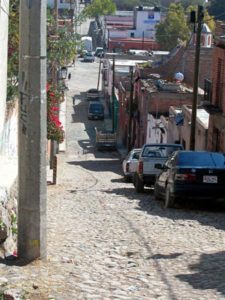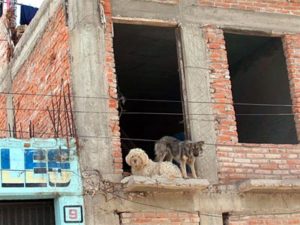If you’re contemplating a lengthy escape from northern winters, think seriously about the Grand Plateau of Mexico. On this great land mass between the eastern and western branches of the Sierra Madre Mountains thrives the economic and cultural soul of the country. Here, Spanish conquistadors ruled, Zorro righted wrongs and caballeros sported ponchos and sombreros. The great colonial cities of Guadalajara, Morelia, Queretaro, Mexico City and Pueblo evolved on this plateau during the Spanish silver mining era and played pivotal roles in the Mexican fight for independence.
Perhaps the most congenial wintering spot on the plateau is San Miguel de Allende. This city of 80,000 and cradle of Mexican independence has corralled more than 2,500 Canadian and American expatriates and attracts an untold number of snowbirds for periods of one to five months. Unlike other colonial cities, the English language is widely spoken. Delightfully mild weather prevails year round and the city exudes a decidedly laid-back atmosphere.
Renting a home in San Miguel de Allende is your first priority. A search on www.vrbo.com reveals offerings ranging in price from $1,000 to $10,000 (U.S.) per month with price variations by season and by length of stay. Rents typically include utilities and housekeeping services. Overall, you will appreciate the quality of housing in San Miguel. House design follows the Moorish style with central courtyards forming an integral part of the living space. Almost always, a colourful but Spartan exterior and a fully gated yard hide flowering gardens, enchanting home designs and quality furnishings.

Apartments are a less costly option with rents ranging from $350 to $1,000 per month. Obtain apartment information through word of mouth, local newspapers and community bulletin boards. Buildings have three to ten units and are mainly in the centre of town. Many offer interior courtyards and rooftop gardens.
Understanding the geography of San Miguel is vital when selecting a rental property. This is a mountain city that huddles in a valley surrounded on three sides by ascending hills. Housing is available on the hills and in the valley.
If you rent on the hillsides, you had best be in excellent physical condition because the walking can be extremely taxing. The main part of the city is at an elevation of 6,200 feet and the fringes are close to 7,000 feet. Oftentimes, houses won’t have direct road access. Even if you take a cab home, you could be walking the last 300 yards over rocky and steep terrain.
Select a home in the central or flat part of the city. Areas like Guadiana and the Jardin are ideal choices. In these locations, you can wander home for lunch or siesta and return to the action without knocking yourself out. If you live in the hills, the walk home leaves you reluctant to repeat the process. Hillside locations sabotage spontaneity.
Cold overnight temperatures are the corollaries of high altitude. Don’t be surprised to wake up in January and February to below freezing temperatures. The good news is that daytime temperatures quickly rise to the mid 70’s making strolling very pleasant were it not for the notorious cobblestone roads and sidewalks.
Cobblestone appears in two varieties in San Miguel. The first is cut stone with mortared joints providing a smooth surface. The roads in the centre of town are constructed in this fashion. Elsewhere, round stones are pounded into gravel providing an uneven road surface that beats the dickens out of cars, shoes and knees. If you have ever walked in a shallow stream with a rocky bottom, you will have some idea of the sensation. This type of cobblestone is typical on the hillsides even when fronting million dollar homes.
The sidewalks of San Miguel are unusually narrow. Two people cannot pass on a sidewalk so one must take to the street. The sidewalks house municipal services including telephone poles, street lighting, water lines, street signs and driveway ramps. Buildings have box windows that extend eight to ten inches over the sidewalk. Always look down to avoid stumbling on water pipes or falling into open service hatches and always look up to avoid street signs and ubiquitous box windows. Other impediments to a pleasant walk are dog droppings and housekeepers. Dogs treat sidewalks as public toilets. To counteract this, housekeepers emerge daily with buckets of soapy water to clean the stones and ambush the unsuspecting stroller with the slick by-product of their efforts.
Perilous roads and sidewalks provide a perfect segue to medical services. Residents rave about their health services. A few American doctors live permanently in San Miguel and work with capable Mexican physicians. You will find holistic practitioners, chiropractors and optometrists. Mexicans don’t generally visit a doctor for minor medical ailments and infections. They go to the pharmacy and explain their symptoms to the counter person who will suggest a variety of drug options.

The focal point of San Miguel is the Jardin (garden). This small park rests in the shadow of the massive Parroquia or parish church. Locals start their day reading newspapers on park benches. The park is a perfect place to converse with fellow travellers. You will also meet the Mexican residents of San Miguel who comprise ninety percent of the population. In spite of economic disparity between the gringos and the Mexicans, the two groups co-exist nicely. You will find the Mexican people extremely polite and eager to help.
San Miguel is justifiably famous for its friendliness. Think of old movies in which strollers doff their hats to perfect strangers and nobody passes without a courteous greeting. That same movie plays every day in San Miguel. A typical encounter begins with a ” Hola, how are you folks?” and ends in a restaurant or bar for drinks and a chat.
The streets around the Jardin teem with restaurants and artisan shops. The food is excellent with prices for every budget. If you stay in San Miguel for two months, you could avoid eating in the same restaurant twice.
Expatriate residents delight in assisting newcomers. Most carry personal information cards that should not be mistaken for business cards. They are akin to the calling cards from Victorian times and form the basis of social contact. If you are open to meeting people, it won’t take long to obtain quite a collection. For the expatriate population of San Miguel, partying is a full-time occupation. Many offer standing invitations to their homes six days a week.
Don’t expect a lot of young tourists in San Miguel. They party in Cancun or Acapulco. Visitors to this city are at least middle aged, most are over 50 and many are over 75. Many of the expatriate residents in the city are elderly but they look fantastic. I chatted with a gentleman in the Guadiana zone who was simultaneously celebrating his 80th birthday and completion of his second-degree black belt in Karate. The man didn’t look a day over sixty. You will find octogenarians in yoga class who are as flexible as those 40 years younger. The bottled water must contain preservatives.
San Miguel de Allende is renowned as a community of artists, writers, potters and actors. Hundreds of people participate in arts and crafts. You can study fine arts and the Spanish language at the Institute Allende. Bellas Artes caters to those with musical and dance interests. Established authors give weekly book-readings and provide training for the hopeful. The athlete will be content with golfing at a nine-hole course and horseback riding through the mountains.
Try grocery shopping in San Miguel as a great source of entertainment. The mercado, which resembles farmers’ markets, resonates with hustle and bustle offering all varieties of fruits and vegetables as well as bakery products and meats. Fruits ripen on the vine in Mexico and arrive at the market within hours of picking. Eve could have tempted Adam with any of this succulent produce.
Excluding housing, the cost of living in San Miguel is affordable. If you eat out at least once a day, attend the theatre occasionally, take the odd side trip and buy groceries and alcoholic refreshments, expect to spend about $300 per week.

Participation is the secret to enjoying yourself in San Miguel de Allende. This city shouts out for your involvement. There is so much to do and see and you can’t truly enjoy the experience unless you jump right into the mix. The abundance of schools, associations, artistic endeavours and charities gives everyone the chance to play a role. If you have special skills, volunteer your help and be rewarded with entry to an entirely different culture. Learn to speak the Spanish language or play the piano. Anything that catches your fancy is open for the taking. Expect a welcome from the entire community as soon as you show up and say you’re interested. There is no language impediment in San Miguel de Allende to hold you back; so go for the gusto and live the life to its fullest.
QUICK FACTS
Founded in 1542, San Miguel de Allende is located in the centre of Mexico,
180 miles (288 km) northeast of Mexico City. To reach the city, fly to Mexico City
and catch an intercity bus at the airport. The bus ride is four hours. As on option,
fly to Leon that is 70 miles from San Miguel and take a one-hour bus ride.
Go to https://portalsanmiguel.com/index.php for detailed info on all aspects of the city.
The website for the Institute Allende is https://www.instituto-allende.edu.mx/indexeng.htm








